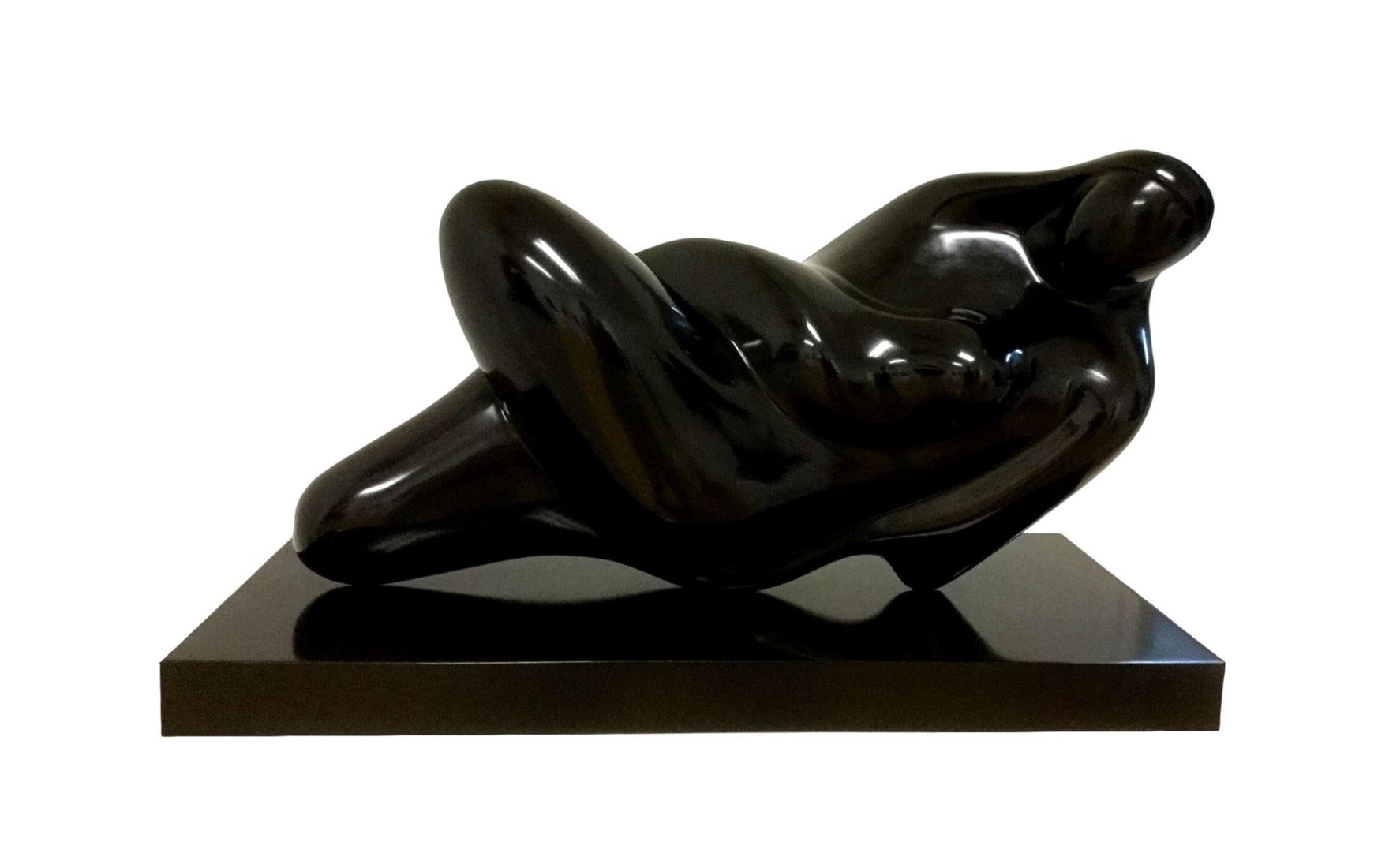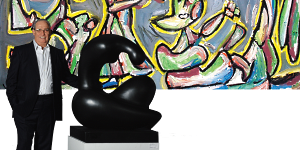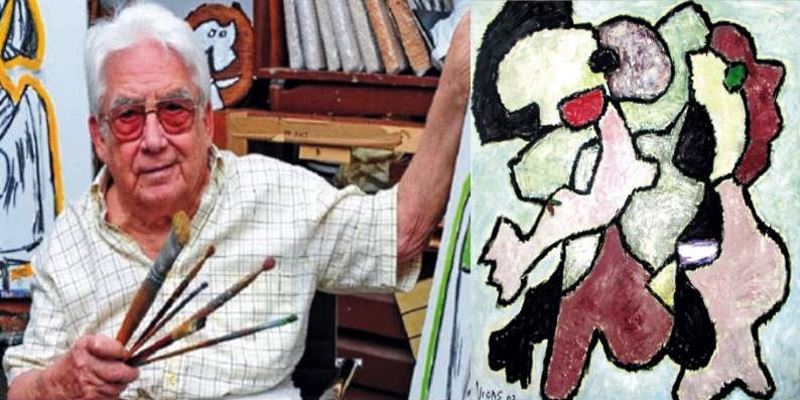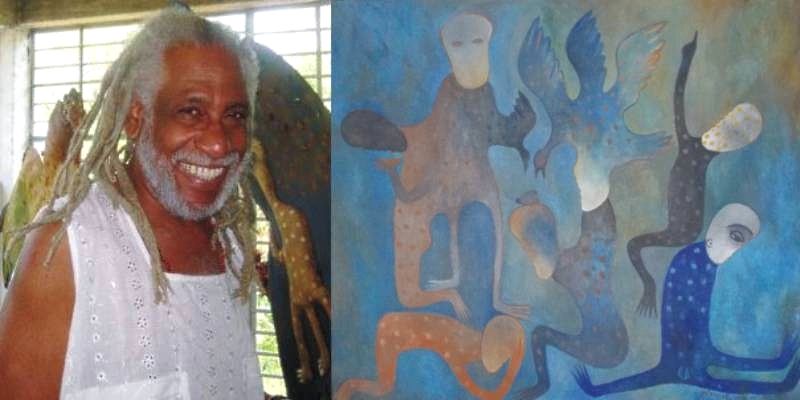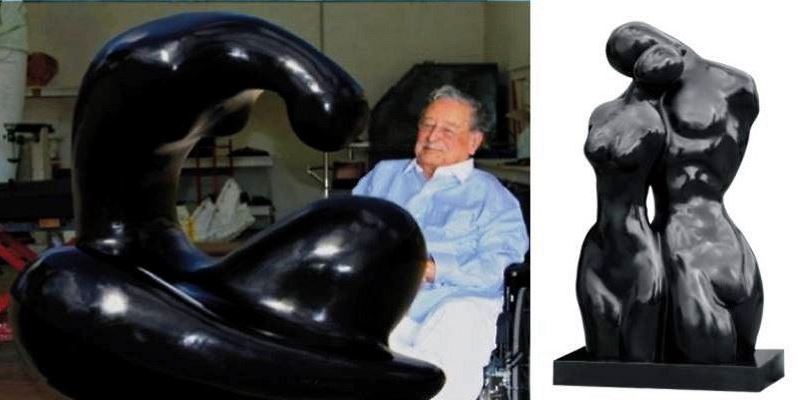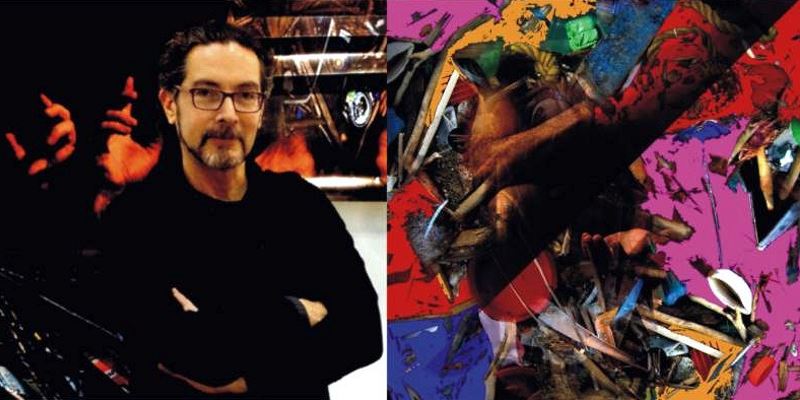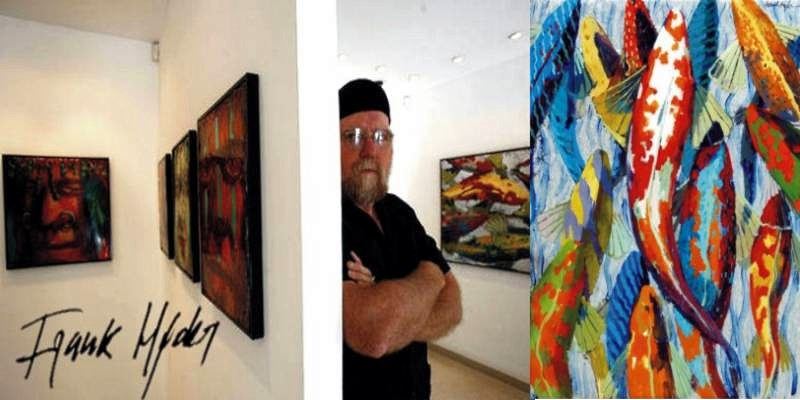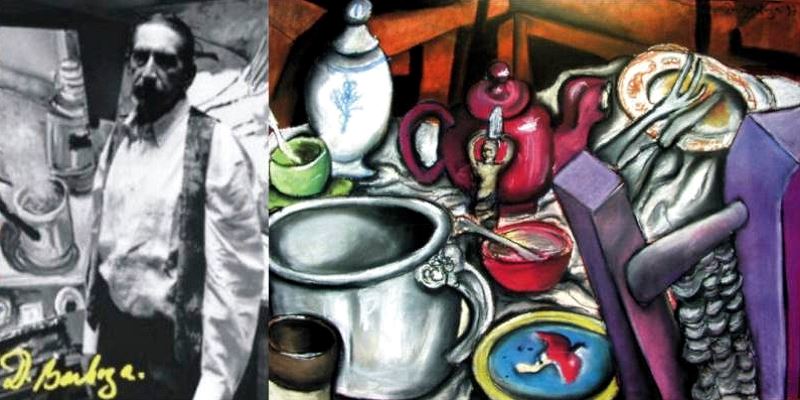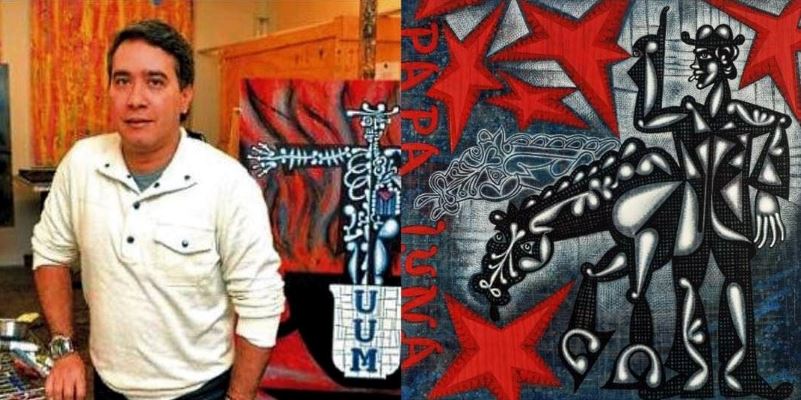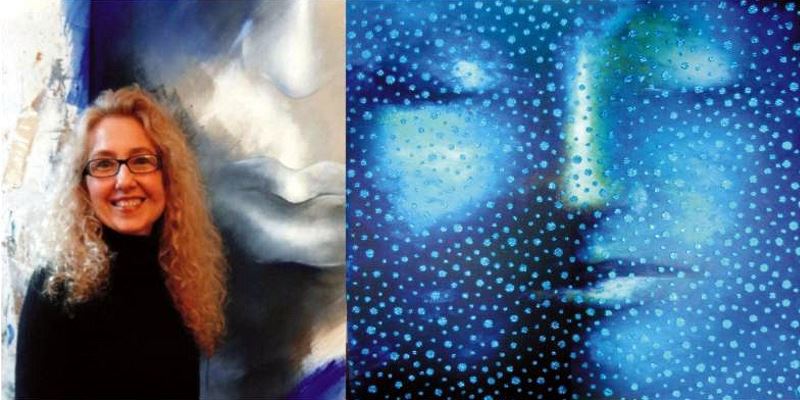Interviewed by Jose Pulido
Asdrubal Colmenárez seems like a woodcutter who wanders in the forest removing the shell of a tree or calculating the age of a eucalyptus. He actually distances himself a little, conceals some shyness and tries to hide in his paintings. He gets agitated submerged behind the scenes, he observes his paintings very closely, scrutinizes details, sees the frames in case one is broken. He does not like to talk directly with someone: he prefers to do it while executing his endless game of cutting off his navel and disconnecting from his works. It seems he never wants to finish them: if he would not stop for a reason known only by his muses, he would continue painting the same picture forever.
His paintings are like sentimental maps, destined to place the passions of those who see them. His sculptures always inspire awe and end filling the eyes with the same effect as the smells of the past trigger in memory. A sculpture made by him lying on a beach or on a street, can extract all the memories of the past that the individual or group have of the times when magic was commonplace.
Although he frequently refers to antiquity and the most remote emotional times of man, the art of Asdrubal Colmenárez is fresh and young, it is a daring act, a rebellious gesture, an irreverent communication. Perhaps this is because Colmenárez is an artist who does not age. It's like all the time would fly to the origin of things, to genesis and authenticity. Towards the rising sun.
Personally, he is a strong man, brave, that does not seem to relax for a second. His place is his workshop. There he unfolds in his environment. His fertility generates expressions, he makes a work grow. For several years he has been touching the theme of eroticism from deep angles and very poetic, as when he offered the public his vision of Odysseus and Homer.
Colmenárez always addresses a theme and develops it until he reaches its shores. His works are not chaotic or capricious. It's like he would be writing a book and he will display it on various canvases or in a group of sculptures. He maintains cohesion, never loses the thread and expressiveness. This year he directly addresses the theme of eroticism. The first question makes him raise his head and stops wandering between racks.
-The theme of eroticism, did it appear suddenly or were you already considering it as a possibility?
In Odyssey, the previous exhibit, one can see many characters that reflect eroticism. Eroticism is inherent to man; you cannot separate man from eroticism or the cultural. In all civilizations eroticism is very important.
Colmenárez shows this time his vision of the female body and he does so as under the guidance of the poetic. It is normal that his experiences and the wealth of his habitual readings help him in the workshop: it is well known that he read Homer and the rapporteurs of tragedies such as Sophocles, Aeschylus and Euripides. Speaking of eroticism he quotes Georges Bataille among others.
Bataille, incidentally, wrote: "A man, a woman, is generally regarded as beautiful as long as their shapes move away from animalism ...."
- Have you found the right woman?
"I think that all men carry in the subconscious, in dreams, in the mind, an image of a woman who can never be found, a fictitious image, utopian, that one makes of a woman ...it is a kind of an ideal. It is an ideal that does not exist ...
- What influences have you invoked for this exhibit?
"My influence as a sculptor is the prisoners that Michelangelo made for the Medici tomb ... you cannot escape the classics ... my readings are the same as you have had or that anyone has had: Artaud, Bataille, Lautremont ... what interests me of the classics is that their eroticism was kind of subversive, although I think that the church ruined it ...
- Why do you think so?
"Because it's something fabulous when you make love for pleasure, but when you have an obligation to multiply yourself, the thing is not so good ... you cannot separate the human being of eroticism ... in 1968 I had the opportunity to go to Pompeii ... I visited the brothel of the city ... there were stone beds and behind the beds there were frescoes depicting various sexual positions that people thought were invented, in addition to the Kama Sutra ... and it appears that such things already existed ... the Vesuvius swept the city in the year 79 BC, but could not destroy the erotic frescoes of that brothel... the sexual act had been painted there, using a special red color, which is red of Pompeii ... the eroticism is not new: it is never new ...
-But it is the transgressor, isn’t it?
"It is always a transgressor because it is something that liberates ... I think those guys are very aggressive, they probable do not make love often. Because after you make love you are quiet ... engrossed ... as in paradise ...
-Inevitably, when it comes to eroticism, the subject of pornography appears ...
"For me it's more pornographic to read in the newspaper that there were seventy deaths in one weekend ... making pornography is easy ... hard is to suggest things that motivate eroticism without falling into the common and obscene image...
Asdrubal Colmenárez displays in Caracas this exhibition that is perceived truly shocking: it's like a painted whirlwind.
The eroticism is relevant
Indeed; it is worth noting that currently, at the Dulwich Picture Gallery in London, there is an unusual and successful exhibition of the image of San Sebastian. The pain and ecstasy attracts and moves the audience from five pieces painted by the same author: the Italian Guido Reni (1575-1642). This exhibition was organized in 2007 by Musei di Strada Nuova in Genoa with pieces loaned by the Museum of Prado (Madrid), Museum of Art of Ponce (Puerto Rico) Photographic Archive Capitolina Art Gallery of Rome and the Auckland Art Gallery, New Zealand. It is the first time that the five pieces come together. The one that is in the Louvre lacked, but it is very fragile and cannot travel.
This exhibition, which theme is San Sebastian, is impressive and overwhelming. The saint, so often painted by Guido Reni, became an erotic symbol, precisely because it involves nudity, pain and ecstasy in one jerk. The eroticism is very tricky: for every human being the connection is different. The Japanese writer, Yukio Mishima, discovered his homosexuality when he was fourteen years old, watching an image of San Sebastian and then expressed it in the novel Confessions of a Mask.
"From the day I became obsessed with the painting of St. Sebastian, I had the habit of unconsciously crossing my hands over the head whenever I was naked. My bodies were fragile, and not even a pale shadow of the abundant beauty of the saint’s body. But once again I spontaneously adopted that position. In doing so, I looked at my armpits. And a mysterious sexual desire arose within me.... "
Misaim also wrote: "In the xylographs of the Genroku period, one can often see that the features of two lovers are strikingly similar, to the point that it is difficult to distinguish male and female. Similarly, the ideal of beauty of the Greek sculpture leads to the striking resemblance between male and female. Can one of the secrets of love be found here? "Is there the possibility that in the innermost recesses of love encourage a desire whereby both men and women are eager to become exactly like the other?”
Talking with the master
Talking about eroticism, we bring up these details to the Trujillo painter, who has delved into this matter, but he has also touched on the love theme from the point of view of the courteous tragedy and thoroughly knows what Plato elucidated in Phaedrus and in the Banquet. That is Platonism, "a fit, an undefined abduction of the reason and the natural sense ... deification."
Colmenárez likes these conversations because it is a voracious reader. It's hard to surprise him with an author. He could spend hours talking about literature, poetry. If someone touches on the subject of painting or sculpture, he becomes introverted and starts again to rummage through his canvases, to escape into the trades of the workshop.
-You continue to refine your language in painting with transparencies, references to different eras, the stories ...
"Yes, I do as a cook ... every day I add ingredients apart from the symbols I've used for some time ... the letters, numbers ... now I incorporated a sort of woven thing so what is behind cannot be seen ...
-You seem to renew your energies every time you present your paintings and sculptures to the public ...
"I came to the conclusion that art is the only free territory we still have in the world... if we have to spend all the energies of life to do so, you sacrifice yourself and spend those energies ... if we do not sacrifice ourselves what do we have left? nothing, because everything else are commitments ... you do art whenever and however you want ...
- Don’t you fear that there might be a negative reaction to your exhibits on eroticism? You know that the double standard is a permanent ambush ...
"To answer that you must go to Freud ... the truth is that the Oedipal relationship is very strong in Latin America ... the influence of the mother figure in a man makes sex always a taboo ... I studied for a PhD where we talked about Casanova and it was said that the womanizer has a very pronounced homosexual side ... Picasso remarked that we all have our feminine side within and it should like that ... people who fear going to one extreme is the people that manifest that double moral ...
-In Asia, particularly in Korea, has permeated your work, according to what we have read ...
"In the East they like more the sculpture than I make because it is totally opposite to painting ... my painting is kind of more violent ... my sculpture is more peaceful ... it is a field of meditation, reflection ... I have sculptures in Seoul (Korea), in Japan, Colombia and Venezuela ... the one in Colombia is in the Metro ...
-Excuse the comment, but you are more excited when talking about the sculpture ...
"I'll tell you one truth: my love is sculpture, but painting sculpture allows me to make sculptures ... because the sculpture is very difficult to place ... no one has the space and the sculpture that I like is definitely big... and who's going to get into his home? In the contemporary building spaces are reducing ...
- What renews you?
"Everybody says that I do not paint as a 70 year old ... and I think that is due to effects of love. But one must make a difference between love and sex. Sex alone just does not work ... well, it is also true that platonic does not exist ...
- And then? "Platonic love is not the search of the ideal woman?
"The ideal is not an accurate form ... it is as many forms ... the ideal is like searching for yourself ... finally, the artists that give life to things do not exist and that's a privilege ... nowadays, the painting is not something that screams look at me ... it is not a landscape to contemplate ... it has become quite the opposite: the painting is what looks at you, which interrogates and questions you,... before you looked at the painting ... now the painting looks at you ... that is one of the most important changes in contemporary art ...
Caracas, Venezuela
April 2008




